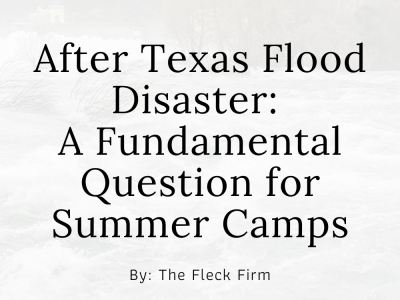After Texas Flood Disaster, a Fundamental Question for Summer Camps
July’s flash flooding of the Guadalupe River in Texas should force those who own and manage summer camps to ask themselves: “Are we in a safe location?” Twenty-seven people who worked at, owned, and were campers at Camp Mystic near Hunt, Texas, were killed by the flooding. The flooding killed over 100 people as of the writing of this blog.
In the upcoming weeks and months, what happened will be thoroughly investigated, but one thing should be clear. Camp Mystic should not have been located by a river known to flash flood, in an area where flood warnings are practically nonexistent. Some places are simply too unsafe for children to be housed, even temporarily.
Location, Location, Location
If your child attends a summer camp, you may overlook the safety of its location. You may focus on transportation, programs, and the quality of the staff. You want your child to get out of the house, make new friends, try new things, and have fun. You may think a lot more about the location’s convenience than its safety.
Some places are unsuitable for kids to congregate. Would you want your child to attend a summer camp that’s next to the following:
- An interstate highway
- An active volcano
- A chemical plant
- A state prison that has problems with escapes
You should add to the list by a river that’s flooded and killed kids attending a nearby summer camp as well.
Other attorneys take contingent fees of 33% to 50% of your settlement.
We want you to keep more of your money.
Our contingent fee is only 30% on cases settled prior to filing suit.
Big Question May Go Unanswered
Summer camps, given they’re responsible for the health and safety of attendees, face a significant amount of potential liability. They should spend resources ensuring they have enough staff, that they’re properly trained, and that attendees are sufficiently supervised. Employees and volunteers should also be screened to prevent sexual predators from having access to campers.
Given all these issues, camp management may overlook the fundamental question of their location’s safety. The camp may have been in the same place for many years, and scarce resources were spent constructing and maintaining buildings, so this is a question that many camps may be reluctant to ask themselves.
Unless there are obvious problems (like the Guadalupe River), it may be a difficult question to answer. A fire could destroy a camp located in a forest, but what are the chances of that happening? Given that the weather has become more extreme and unpredictable, this is a question that must be asked.
Was Camp Mystic a Time Bomb Ready to Go Off?
The camp is located in an area known as “Flash Flood Alley,” according to USA Today, because the Guadalupe River Basin is one of the most dangerous areas in the US when it comes to flash floods:
This region is among the nation’s most prone to flash flooding, known for its propensity for fast and furious flooding when extreme rain falls, Alan Gerard, CEO of weather consulting company Balanced Weather said. As bountiful moist air from the…Gulf of Mexico, moves over the steep hills, it can dump heavy rain.
Experts say the flooding was not a surprise, based on historical and prehistorical data:
“The flooding was certainly extreme but it should not have been historically unexpected,” said political scientist Roger Pielke, Jr., in an email. “The documented record of extreme flooding in ‘flash flood alley’ goes back several centuries, with paleoclimatology records extending that record thousands of years into the past,” he said.
The New York Post reports a similar calamity at a Texas summer camp on the banks of the Guadalupe River that killed ten in July 1987. The river rose 25 feet in 45 minutes, swamping a bus and van carrying people trying to escape the flooding camp.
Despite the river’s long and deadly history of flooding, the area lacks a functioning flood warning system. The New York Times reports:
Eight years ago, in the aftermath of yet another river flood in the Texas Hill Country, officials in Kerr County debated whether more needed to be done to build a warning system along the banks of the Guadalupe River.
A series of summer camps along the river were often packed with children. For years, local officials kept them safe with a word-of-mouth system: When floodwaters started raging, upriver camp leaders warned those downriver of the water surge coming their way.
But was that enough? Officials considered supplementing the system with sirens and river gauges, along with other modern communications tools. “We can do all the water-level monitoring we want, but if we don’t get that information to the public in a timely way, then this whole thing is not worth it,” said Tom Moser, a Kerr County commissioner at the time.
In the end, little was done. When catastrophic floodwaters surged through Kerr County last week, there were no sirens or early flooding monitors. Instead, there were text alerts that came late for some residents and were dismissed or unseen by others.
The flash flood time bomb finally went off at Camp Mystic, taking 27 lives. Its owners must have known of the river’s dangers, yet put their lives, and the lives of their staff and campers, into the hands of a flood warning system consisting of phone calls that may go unanswered and text messages that may not be read.
If wrongful death lawsuits are filed against the camp, this will be the key issue. If summer camp owners don’t ask themselves critical safety questions and injuries or deaths happen, personal injury attorneys will ask those questions to juries. The camps and their insurers won’t like the answers.
Contact Us Today
The Fleck Firm is here to help you and your family after your child is injured or killed due to negligence committed by summer camp management. We are dedicated and compassionate when fighting for our clients. Call The Fleck Firm for a free consultation at (270) 446-7000 so we can discuss the situation, Kentucky law, and your best options. Insurance companies have lawyers. You should have one, too.








